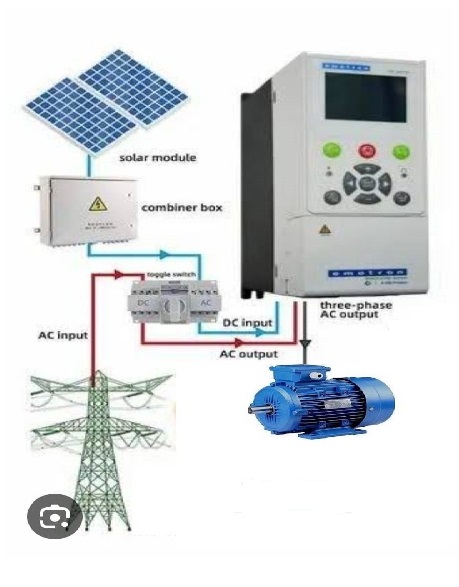Solar Aata Chakki: Harnessing the Power of the Sun for Sustainable Grain Milling
Solar Aata Chakki: In today’s world, where sustainability is becoming a key focus, solar energy is leading the way in transforming traditional industries. One such transformation is the rise of solar aata chakkis—flour mills powered by solar energy. These solar-powered flour mills offer an eco-friendly alternative to conventional electricity or fuel-driven mills. Solar aata chakkis are a growing trend in India, especially in rural areas, offering the perfect blend of green energy and innovation. This combination makes grain milling both efficient and sustainable.
What is a Solar Aata Chakki?
A solar aata chakki is essentially a flour mill that runs on solar energy. It uses photovoltaic (PV) panels to capture sunlight and convert it into electricity, which powers the milling process. The idea is simple yet effective: it harnesses the abundant sunlight available in many parts of India to power the mill, which reduces dependence on traditional electricity sources and fossil fuels.
How Does a Solar Aata Chakki Work?
The core components of a solar aata chakki include:
- Solar Panels: These capture sunlight and convert it into electricity. The more sunlight they receive, the more efficient the energy generation.
- Battery Storage: Solar aata chakkis often come equipped with batteries to store excess energy generated during peak sunlight hours, allowing them to run even when the sun is not shining.
- Inverter: The inverter converts the DC (direct current) generated by the solar panels into AC (alternating current), which powers the mill.
- Aata Chakki (Flour Mill): The mill itself grinds grains into flour, just like a traditional flour mill, but without relying on external electricity or diesel generators.
Benefits of Solar Aata Chakki
- Eco-Friendly: Solar atta chakkis reduce carbon emissions by utilizing clean energy, making them an environmentally responsible choice for rural and urban households alike.
- Cost-Efficient: After the initial installation, operating a solar aata chakki is incredibly cost-effective. It significantly reduces electricity bills and eliminates fuel costs.
- Energy Independence: By using solar power, users of solar aata chakkis can operate independently of power outages and rising electricity costs.
- Low Maintenance: Solar systems generally require minimal maintenance, which adds to the long-term savings for users.
- Sustainable Rural Development: For rural India, where electricity supply is inconsistent, solar aata chakkis offer a reliable solution for local businesses, farmers, and households to grind their grains and meet their food processing needs.
Solar Aata Chakki: A Game-Changer for Rural India

One of the major advantages of solar aata chakkis is their potential to drive rural development. India, with its abundant sunlight and large rural population, perfectly benefits from this technology. In many villages, erratic power supply has made grain milling an expensive and inefficient process. A solar-powered aata chakki changes that by offering uninterrupted operation, reduced costs, and greater autonomy for farmers and small business owners.
Vox Solar: Your Partner in Solar Aata Chakki Solutions
At Vox Solar, we understand the importance of sustainability and energy efficiency in today’s world. We design our solar aata chakki solutions to bring the benefits of solar power to households and businesses across India. We offer a range of solar-powered flour mills that are easy to install, reliable, and highly efficient.
Whether you’re a farmer looking to process your grains or a small business owner aiming to reduce operating costs, Vox Solar’s solar atta chakkis offer the ideal combination of modern technology and environmental consciousness. Our expert team will guide you through the installation process, ensuring that you reap the maximum benefits of solar power for years to come.
Conclusion
As the demand for sustainable solutions grows, solar aata chakkis represent a significant step forward in reducing the environmental impact of traditional grain milling. With the power of the sun at your disposal, you can lower your carbon footprint, cut costs, and contribute to a greener planet. By choosing Vox Solar, you’re not just investing in a flour mill—you’re investing in a brighter, more sustainable future.
Switch to solar today and empower your home or business with Vox Solar’s innovative solar aata chakki solutions.
FAQs About Solar Aata Chakki
Is solar aata chakki suitable for rural areas?
Yes! Solar aata chakkis are particularly beneficial for rural areas where electricity supply is often unreliable. Since they run on solar power, they provide an independent, cost-effective solution for grain milling without the need for grid electricity or fuel.
Can a solar aata chakki operate at night or on cloudy days?
Yes, most solar atta chakkis come with battery storage that can store excess solar energy generated during the day. This stored energy is used to power the mill during cloudy days or nighttime when sunlight is not available.
What is the lifespan of a solar aata chakki?
The lifespan of a solar atta chakki largely depends on the quality of the solar panels and the mill itself. Solar panels typically last for 25-30 years, while the flour mill can last for many years with proper maintenance.
How much does it cost to install a solar aata chakki?
The cost of a solar atta chakki depends on the size and capacity of the system, the number of solar panels needed, and whether battery storage is included. While the initial setup cost may be higher than a traditional flour mill, the long-term savings on electricity and fuel make it a cost-effective investment.
Do solar aata chakkis require maintenance?
Yes, but maintenance is minimal. Clean the solar panels regularly to ensure maximum efficiency, and check the inverter and battery storage system periodically for optimal performance. Routine maintenance of the flour mill is also necessary.
Can I upgrade my existing flour mill to a solar-powered system?
Yes, in many cases, an existing flour mill can be retrofitted with solar power by adding solar panels, an inverter, and a battery storage system. It’s best to consult a professional like Vox Solar to assess your current setup and recommend a suitable upgrade.
How much space do I need for the solar panels?
The space required for the solar panels depends on the energy needs of your atta chakki. Typically, a moderate-sized system would require about 100-200 square feet of space on a rooftop or in an open area with plenty of sunlight.
Is solar aata chakki eligible for government subsidies?
Yes, the Indian government offers subsidies and incentives for solar energy systems under various schemes, including PM Surya Ghar Yojana. You may be eligible for financial assistance to offset the cost of installing a solar atta chakki.
How do I install a solar aata chakki?
Installation is usually handled by a professional solar installer. At Vox Solar, we offer end-to-end services, from assessing your energy needs and designing the system to installing and maintaining your solar atta chakki.
What types of grains can be processed using a solar aata chakki?
A solar atta chakki can grind a variety of grains, including wheat, rice, maize, millet, and more. It functions just like a traditional flour mill but is powered by solar energy.
Can I use a solar aata chakki for commercial purposes?
Yes! Solar atta chakkis are a great choice for small and medium-sized commercial milling operations, especially in rural areas. They offer an eco-friendly and cost-effective alternative to traditional mills, reducing operational expenses in the long term.
Also Read:












What Is Virtual Net Metering?
October 25, 2024[…] Solar Aata Chakki […]
Solar Business Opportunities In India
October 25, 2024[…] Solar Aata Chakki […]
TOPCon Solar Panels
October 25, 2024[…] Solar Aata Chakki […]
Solar Solutions For Indian Agriculture
October 26, 2024[…] Solar Aata Chakki […]
Agriculture Solar Solutions: A Game-Changer For Farmers - Vox Solar
December 28, 2024[…] Solar Aata Chakki […]
Solar Solutions For Indian Agriculture: Benefits Of Solar Water Pumps And More - Vox Solar
December 28, 2024[…] Solar Aata Chakki […]
Solar Business Opportunities In India: A Guide To Growth And Sustainability - Vox Solar
December 28, 2024[…] Solar Aata Chakki […]